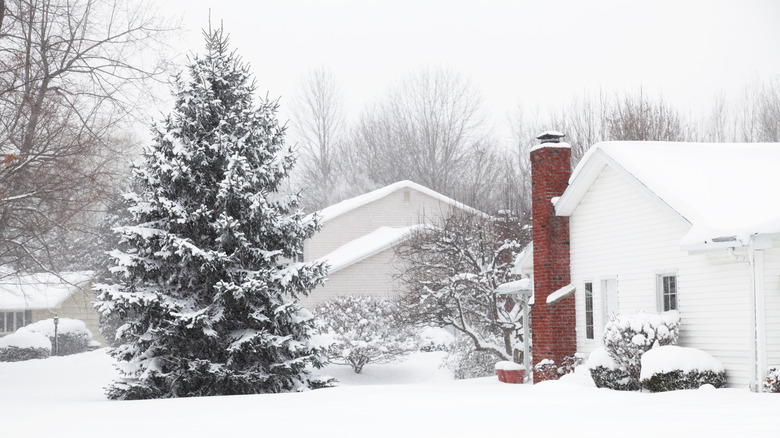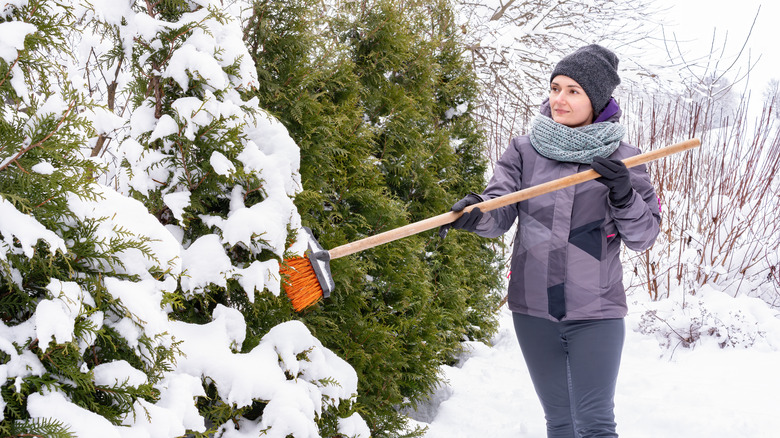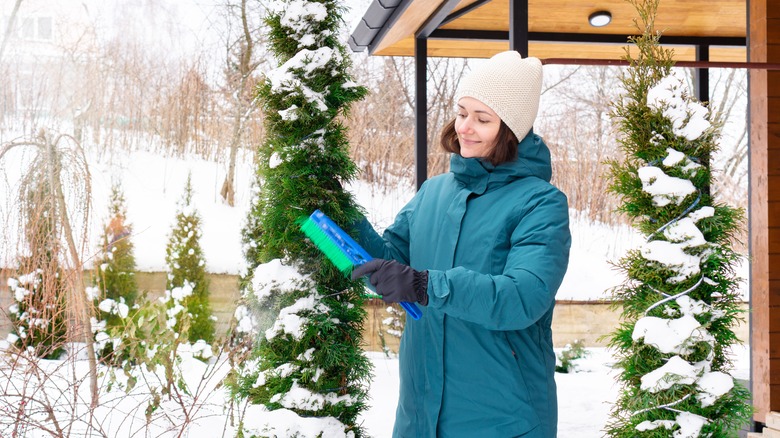The One Thing You Should Never Do To A Snow-Covered Tree
The first snowfall of the season can turn your yard into a winter wonderland. A light dusting of powder is a beautiful sight as it blankets the landscape, and the world seems quiet and peaceful. As time wears on and more winter storms pass through, however, the peaceful quiet is often interrupted by the sound of tree limbs straining and breaking under the weight of the flurries that have accumulated. Winter can put stress on the trees in your yard as each snow shower adds more of a burden to its branches and overall health. In an effort to relieve a tree of excess weight, it can be tempting to give a tree a firm shake to release the piles of snow that have collected in the branches. According to arborists, however, you should never shake a snow-laden tree.
When a snowy tree is shaken, there is a great danger of doing more harm than good. The tree's branches, already stressed from the burden of the extra weight, can easily break when the snow is removed this way. Too many damaged limbs can threaten the life of the tree if it's unable to recover from the damage, especially if it's already weakened by winter. In addition, there's always the risk that broken branches can suddenly snap and injure anyone standing beneath. Experts suggest that the best way to remove excess snow from tree branches is by using a broom instead.
Gently brush the snow off
Using a broom or a brush is a gentler way to remove snow from your tree branches than shaking the tree. Slowly lift the broom in an upward motion, beginning with the highest branches that you can reach while standing on the ground. Don't use a ladder, as the branches can spring back unpredictably and put your safety at risk. Try not to stand directly underneath the area that you're treating so that you're not showered with snow or struck by any falling limbs. A broom is a better choice than other gardening tools, such as a rake or a hoe. The intention is never to strike the tree and risk doing further damage. Make your way methodically around the area, and then repeat this procedure as often as necessary. Pay attention to additional accumulation that may fall from the roof, which can collect in your tree branches and add another load that needs to be brushed off.
While most trees have some flexibility to withstand the weight of extra snow for a short period of time, keep in mind that their resistance can be affected by the time of year and how much foliage remains on their branches. For example, snow that falls in early autumn will add extra weight to trees that have not lost their leaves yet. The same is true for a storm in late spring when new leaves have begun to grow and will collect more weight from a snowfall.
Prepare your trees for winter
There are steps you can take to prepare your trees for a winter storm, such as removing growth that is already in poor condition. Some dead branches will break off during the winter when burdened by snow, but don't wait for nature to prune these limbs off your trees. If there are any areas that will droop too low once they become covered in snow, trim these back as well before winter begins. Your trees will also benefit from being watered consistently during the autumn season, so that they are well hydrated before the taxing winter months. It may also be helpful to bind branches together to create extra stability, which will prevent too much snow from weighing them down. Contact an arborist for assistance with this procedure, especially when it comes to the process of binding the branches of larger trees.
While it's possible to brush snow off your tree, this method won't work if the branches are covered in ice. Even a gentle effort to brush or shake an icy tree can cause limbs to break. It's also not recommended to spray water on the tree to try to melt the ice because, inevitably, more ice will form from the moisture. Never apply a salt mixture to a tree either, as the salt will damage the root system as it melts into the ground. The best decision at this point is to wait for it to thaw.


